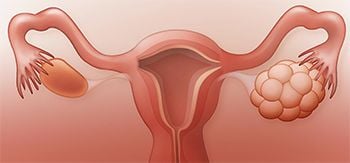Polyps often resemble skin tags, but on the inside. Like other polyps that can appear in your body, ovarian polyps are usually non-cancerous, but can get in the way of normal functioning. They also may lead to cancer if not removed. While they sometimes exhibit no outward symptoms, they can cause pain if they grow too large. If you experience any pain, discomfort or excessive bleeding, seek an examination from your skilled gynecologist at Century Medical and Dental Center in Brooklyn. Call today for an appointment.

Distinguishing the differences between ovarian polyps, uterine fibroids, and ovarian cysts can seem daunting. Although each may trigger similar symptoms, your best Brooklyn gynecologist devises different treatment plans, depending on which you have:
Doctors are still researching to find the exact cause of ovarian polyps, but some suggest that inflammation and extra estrogen may play a role, especially since endometrial polyps form from uterine lining material growing outside the uterus. Although most polyps are benign, they often grow into rapidly dividing cells. Ovarian polyps tend to grow in bunches or become very large. These types of polyps can later become cancerous or interfere with conception or pregnancies.
Ovarian polyps may show no symptoms or may cause a painful twisting condition called torsion. Torsion not only affects the normal functioning of the ovary, but also may require the removal of that ovary. Before any treatment, your doctor determines whether your ovarian polyps affect your normal menstruation, ovarian function or pregnancy desires.
Polyps fall into two main categories: pedunculated and sessile. The differences involve:
Both types of polyps may have smooth or bumpy, irregular surfaces, but nothing about the texture indicates its type, cause or possible malignancy. Many women aren’t aware of polyps because most remain so small as to be undetectable and asymptomatic.
Most polyps remain small and go undetected. They represent benign tissue that doesn’t hurt you. Occasionally, though, complications from polyps result in:
You may be at higher risk for developing polyps if you:
After detecting your polyps through a pelvic exam, ultrasound or x-ray, your Brooklyn gynecologist at Century Medical and Dental Center determines the best treatment option for you. Treatments are limited to:
Most gynecologists perform laparoscopy surgery to remove ovarian polyps. This minimally invasive procedure allows your doctor to access your abdomen through tiny incisions. By inserting tubes with a camera, tiny scalpel and suction equipment, your doctor excises the polyp and suctions it out. If she discovers a sessile polyp, she might carefully cut away the polyp while retaining as much of the healthy ovarian tissue as possible. These procedures are performed on an outpatient basis.
“Friendly doctors and staff! Office was clean and comfortable. Doctor was caring and knowledgeable, taking time to really listen to me and answer all my questions.” - Katie Thigpen
200 Livingston Str,
Brooklyn, NY 11201
908 reviews
770 Flatbush Ave
Brooklyn, NY 11226
234 reviews
827 11th Ave
Manhattan, NY 10019
88 reviews
260 Ave X
Brooklyn, NY 11223
261 reviews
180 Myrtle Ave
Brooklyn, NY 11201
90 reviews
2315 3rd Ave
New York, NY 10035
40 reviews
You usually need just a minimal amount of over-the-counter pain relievers after laparoscopic surgery since it’s one of the least invasive surgical methods. Most gynecologists suggest resting quietly for a few days to allow your body to heal and ensure there are no complications from the surgery. Your doctor sends an excised polyp to the laboratory for testing to determine if it’s malignant.
At Century Medical and Dental Center, you have access to a range of experienced medical specialists. Consult with your doctor of medicine today regarding any symptoms of concern that may point to ovarian polyps. The sooner you receive treatment, the more likely you’ll have a successful outcome.
Century Medical and Dental Center is an accredited healthcare facility in NY that operates in accordance with Article 28, a public health law. This law regulates and recognizes accreditation for public healthcare facilities, ensuring they are licensed and operated correctly. By undergoing the Article 28 process and achieving accreditation, Century Medical and Dental Center demonstrates its commitment to meeting the highest standards of care.
As a multidisciplinary medical center, we have highly qualified doctors, nurses, and support staff who are working hard to provide the best medical care to patients in Midtown Manhattan, NY, Downtown Brooklyn, NY, including Brooklyn Heights, Dumbo, Prospect Heights, Park Slope, Clinton Hill, Boerum Hill, Red Hook, Harlem, Gravesneck, Flatbush, and Bedford-Stuyvesant.